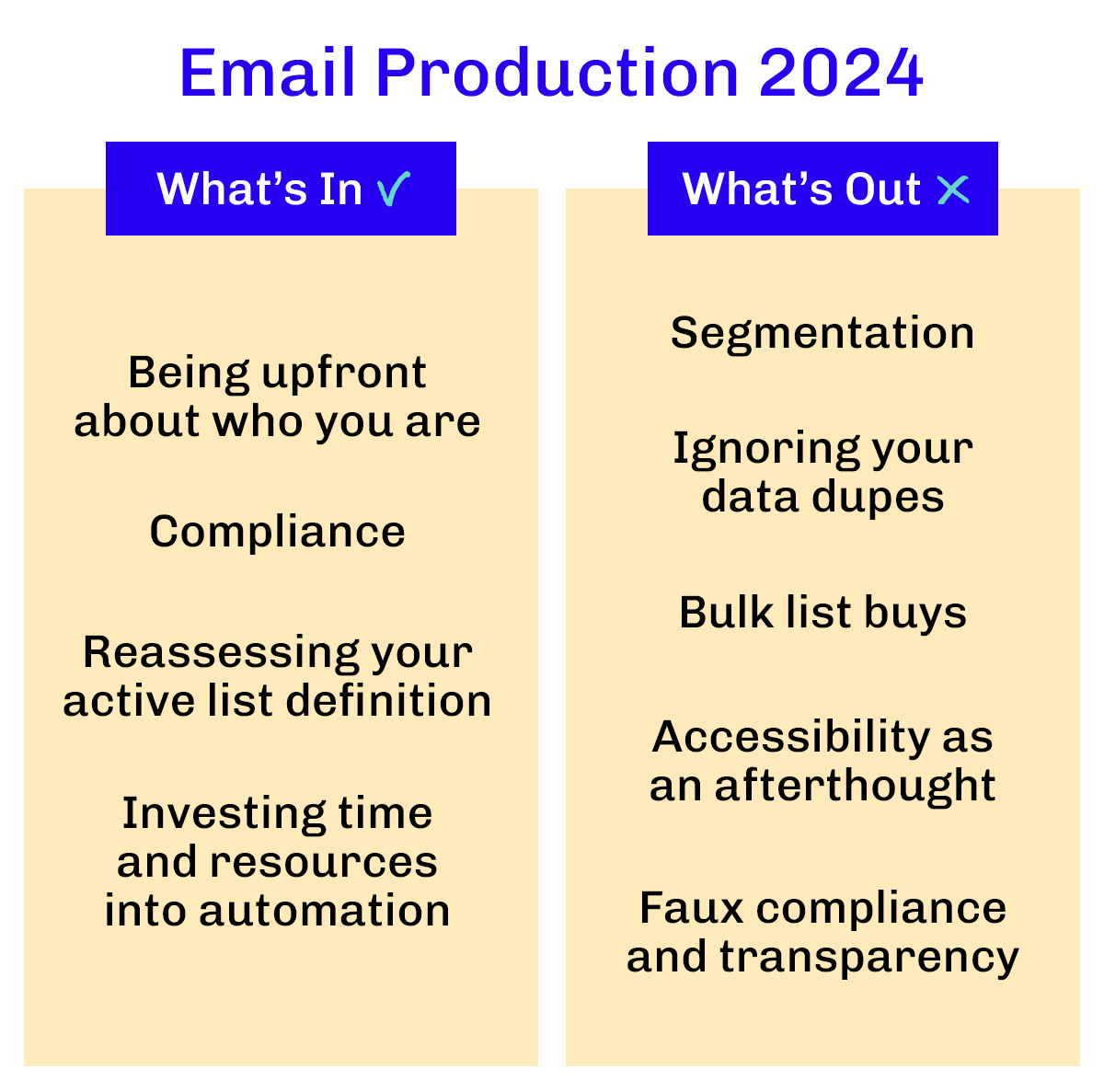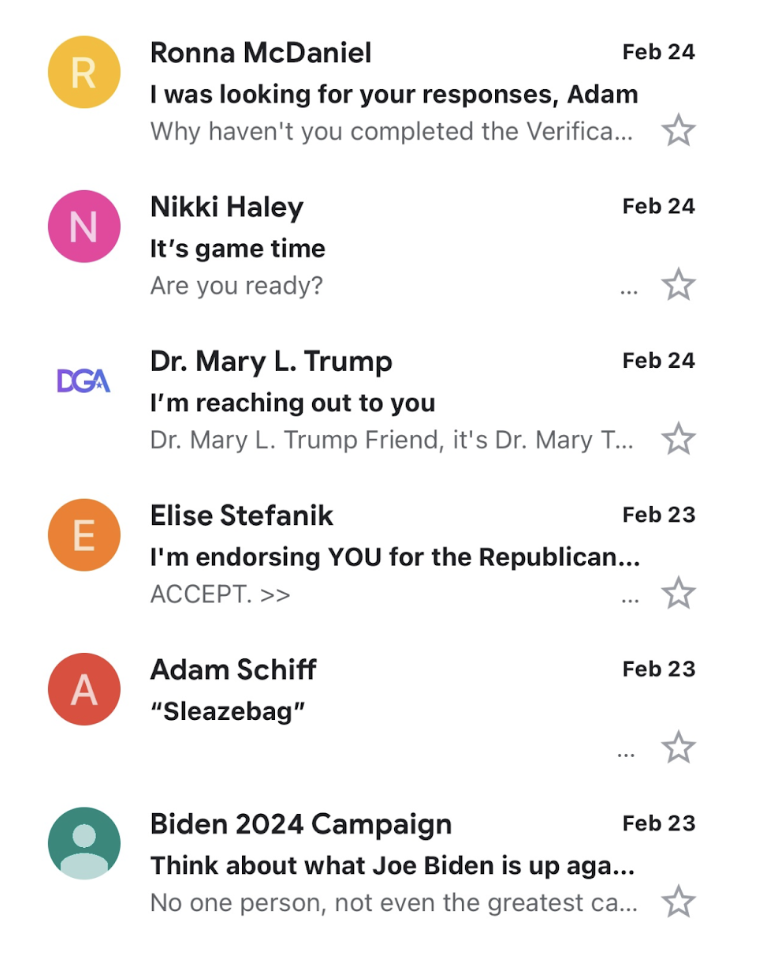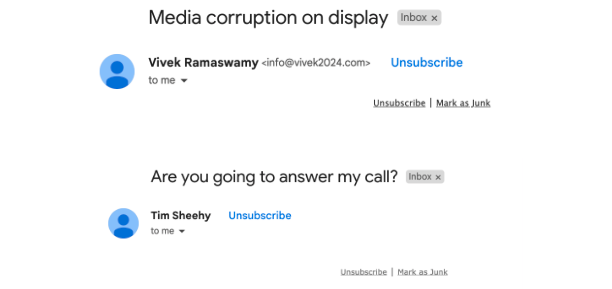Early this year, we noticed that Vivek Ramaswamy — still a presidential candidate at the time — had included a “mark as junk” link in the header of his emails. This tactic appeared to be refreshingly transparent and user-friendly, but the issue? The link was actually a one-click unsubscribe link — allowing the sender to avoid a formal spam complaint.
In another corner of the email ecosystem, in a listserv of email practitioners, one member recently shared he was feeling hesitant about who he was planning to vote for in an upcoming Democratic primary for Senate. Why? His preferred candidate had just sent him an email referring to him as Rick. His name is not Rick — indicating that the campaign had most likely bought a list with bad data (or mishandled their data).
We’ve long had deep conversations at Blue State about email production, deliverability, list health, and CRM maintenance, but the trends we’re seeing right now — and the considerations that emailers should explore in 2024 –– are worthy of even more attention.
Our “ins and outs” list below is food for thought. We’re curious if you agree or disagree and if you have any recommendations or watchouts to add! Send us a note

In: Being upfront about who you are
Supporters’ email addresses are being bought every day, with hash files selling like hotcakes, and they’re getting emails from 16 different organizations with the word “Dem” or “Blue” in their names. Additionally, shadowy organizations are sending generic asks from “POTUS Alert” senders that ask readers to “donate to SAVE democrats,” but they’re not being upfront about who they are or what donations are going to. Spoiler alert: It can be a scam PAC.
To avoid being mistaken for those bad actors, and to build more trust with donors, include a header logo so that supporters can recognize you. That logo can act as an official seal — with a short pitch in it too.
Likewise, many organizations will leverage alternate “From Names” to catch your eye and offer information about the sender and email content. This is a useful tool to stand out in the inbox, but a single, consistent From Name is also an important consideration. Recipients will generally spend just fractions of a second evaluating an email before opening it or moving on, and muddying the waters by sending too frequently from non-specific values like “2X Match” and “Limited Offer” can confuse supporters and increase spam complaints.
Another option for maintaining consistent branding is setting up BIMI, or Brand Indicators for Message Identification. BIMI is an authentication measure set up on your sending domain that, depending on your recipients’ exact context, will display a sender logo for any emails from your domain. In Gmail, this renders something like the below on desktop:

Our friends at the DGA use their logo to stand out in the iOS Gmail app:

While this can be a very useful tool, fair warning, intrepid email friends: It requires SPF, DKIM, and DMARC TXT records to be set up on your sending domain, in addition to an SVG of your planned, trademarked logo (Contact your friendly neighborhood MarTech or Development team member to set these records up). There are also significant costs associated with obtaining a “Verified Mark Certificate”, another requirement for marketers looking to go this route.
In: Compliance
Late last year, Google and Yahoo announced new recommendations for bulk senders to ensure delivery and avoid placement in spam folders. Specifically, since February 2024, they require correctly configured DMARC records on sending domains, valid, one-click list-unsubscribe links, and in Google’s case, they announced some more specific spam complaint threshold guidance.
A word of warning: DMARC records can be configured in numerous ways, and must be aligned with SPF and DKIM records that you have set up. Free, online tools like DMARCian for checking your domain records can be useful, but if you’re unfamiliar with domain record syntax and domain/subdomain structures, you can be easily misled by these tools, which generally only evaluate the presence of a record and its syntax. Contact your friendly neighborhood MarTech or Development team member to be 100% certain.
In: Reassessing your active list definition
We support programs that include recent donors in their active list definitions — but we also suggest not going too far back in that parameter. Donor activity does indeed indicate buy-in and supporter interest, but does not necessarily correlate to email engagement activity. No matter what a human is doing in the great big world outside of their email, Google or the receiving email service only sees what their users engage with in their inbox. When it comes to spam algorithms, they don’t know if someone donated via your website just last week, or signed a Mobilize petition yesterday. Additionally, seasoned and trained supporters will use email addresses that they don’t actively check when they make a donation.
We recommend reviewing your active list criteria regularly to make sure you’re neither casting too wide a net with who you target, nor leaving potentially-engaged supporters on the table by excluding them.
In: Investing time and resources into automation
We understand that time and resources can be scarce, and sometimes you’re just trying to get today’s email approved and out the door. We’ve been there! We still suggest considering how your team might be able to plan out and set up strategic, segmented, automated email journeys one-by-one — using data and every feature of your CRM to to make sure that priority audiences are in intentional, optimized, and automated series as much as possible based on their active status and donor status.
These will act as always-on, strong streams of revenue happening in the background as your team also executes your planned calendar. These series can include:
- Donor/sustainer thank you series
- Lapsed donor reactivation series
- Active for three months, hasn’t donated yet series
- Recurring donor reactivation series
- Recurring ask 30 days after first donation
- Inactive prevention trigger
- Failed transaction followup
Don’t know where to start? Reach out to us! Our team has seen strong success in sending these personalized, targeted emails to audience segments and then setting them as automated series. Some have even yielded better results than sending an evergreen fundraising email to the full active list.
Speaking of staying strategic with your segmentation, let’s move on to our “outs” for 2024…
Out: Segmentation
Okay, okay, hear us out for a second! We support and believe in audience segmentation. It allows you to understand your sender reputation more granularly, personalize emails for specific kinds of supporters, test creative concepts, and much more!
But during EOY, EOQ, and other high-volume moments with an acronym, many organizations have the inclination to produce multiple audience segments (non-donors, donors, monthly, midlevel, high-dollar, etc.) for every. single. send. This can quickly turn a 15 email campaign into a 75 email campaign. While there are benefits to separating and tracking each email segment, it’s worth considering the potentially diminishing returns of such segmentation, and if the staff time and resources it takes to build, QA, and report on separate audience segments for every single email is really worth it. In some cases, we find that dedicating that time to a couple of strong, standout concepts, and using conditional content and personalization in one version of an email build, can save time and perform as well or better than an equivalent version for 8 unique segments.
Out: Ignoring your data dupes
Some CRMs and email tools create multiple records for the same supporter each time they engage, or match to your existing records inconsistently. This can cause all kinds of data hygiene headaches, but in particular, can mean you have a number of old records containing supporters’ deadnames.
We recommend you 1) talk to your CRM/ESP provider about what options they have available to de-duplicate records and customize/streamline match logic for existing records, and 2) build emails with the possibility of deadnaming in mind, especially for sends to less active audiences who may not have had the opportunity to update their Name in your database. You may even want to consider including a link that says some version of “Not your name? Update your info here.” This can require some upfront work, but once set up, you have a built-in method of capturing updated info from records already on your list specifically at their request.
Out: Bulk list buys
Another surefire way to call your supporters by incorrect names is to buy, swap, and rent every email address you can, without consideration for any other information about the person behind the address, or indeed if they’ve even opted into receiving your emails. There are countless reasons why this is inadvisable, but if increased spam complaints, deliverability nightmares, and the general pollution of bulk email as a channel for advocacy and fundraising are not enough to persuade you to avoid these methods, consider that in many cases, you’re dealing with out-of-date information that can lead you to email “Rick”.
Out: Accessibility as an afterthought
It can be tempting to try to leverage as many eye-catching special characters as possible, especially as inboxes get more crowded and you compete for attention. We have nothing against the occasional, playful use of an emoji every now and then, but the use of some special characters can prevent mobile readers from actually being able to read what the email is saying — this goes for SMS too.

(Reader, Mark Kelly did not tumble.)
(Also, the donations to this email did not actually go to support Mark Kelly. See our “Being upfront” point above.)
Many premium email testing tools like Litmus, Email on Acid, or even free tools like WebAIM.org offer accessibility audit tools to ensure your emails are screen reader-friendly, and use accessible color contrast pairings, appropriate font sizing, image alt text, and more. While it can be daunting to tackle all possible issues, we encourage all email program managers to familiarize themselves with WCAG guidelines and consider how these may affect your content in both web and email.
Out: Faux compliance and transparency
The general rules of the email road, dictated either by law or norm, are your friend! When Google advises you to include one-click unsubscribe links, or gives you spam complaint thresholds to monitor for, you should take the hint! These email services go to great lengths to ensure their customers have the ability to report spam and unsubscribe from emails easily, and in general, trying to game these measures is asking for trouble and can lead to larger issues down the line.
In some cases, senders will attempt to bury an unsubscribe link in 8px light gray font in their email footer, lost in several paragraphs of text you have to squint to read. In addition to being annoying for any recipient, this is a bad idea for you as a sender. If someone doesn’t want to receive your emails, you should make opting out as easy as possible. They are unlikely to engage with your content, and an unsubscribe is vastly preferable for you to a spam complaint or repeatedly ignored messages, both of which hurt your sender reputation.
In some other cases, a sender may include a prominent unsubscribe link above their header logo. That’s great! The problem? These political candidates also included a “Mark as Spam” link of their own — a deceptive tactic that feigns transparency.

Inspecting these links reveals that they, in fact, are both identical one-click unsubscribe links. These senders are tricking recipients that might otherwise have marked this email as spam in Gmail. Crafty? Yes. Unethical? Definitely. A violation of their ESP Terms of Service? Probably. We find that a simpler and more honest solution is: (a) not spamming people in the first place, and (b) monitoring authentic spam complaints as closely as possible to ensure that the people you want to see your emails are indeed seeing them.
In conclusion
The email landscape has changed substantially since even a year ago, and navigating the considerations posed by new developments and trends can be difficult. Between now and November 2024 we know that America’s hottest club is going to be the Democratic donor’s inbox. By following what’s IN and ditching what’s OUT, you can know that you’re building and sending your emails the best way for your organization, your team, and your supporters.